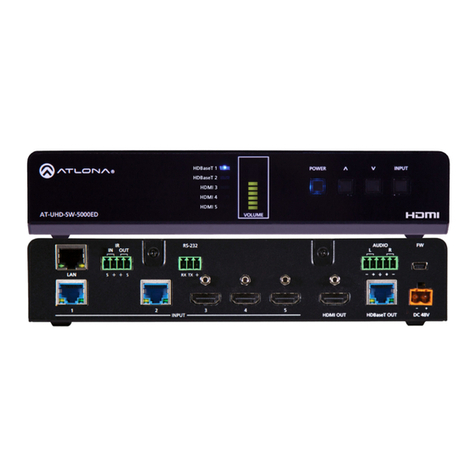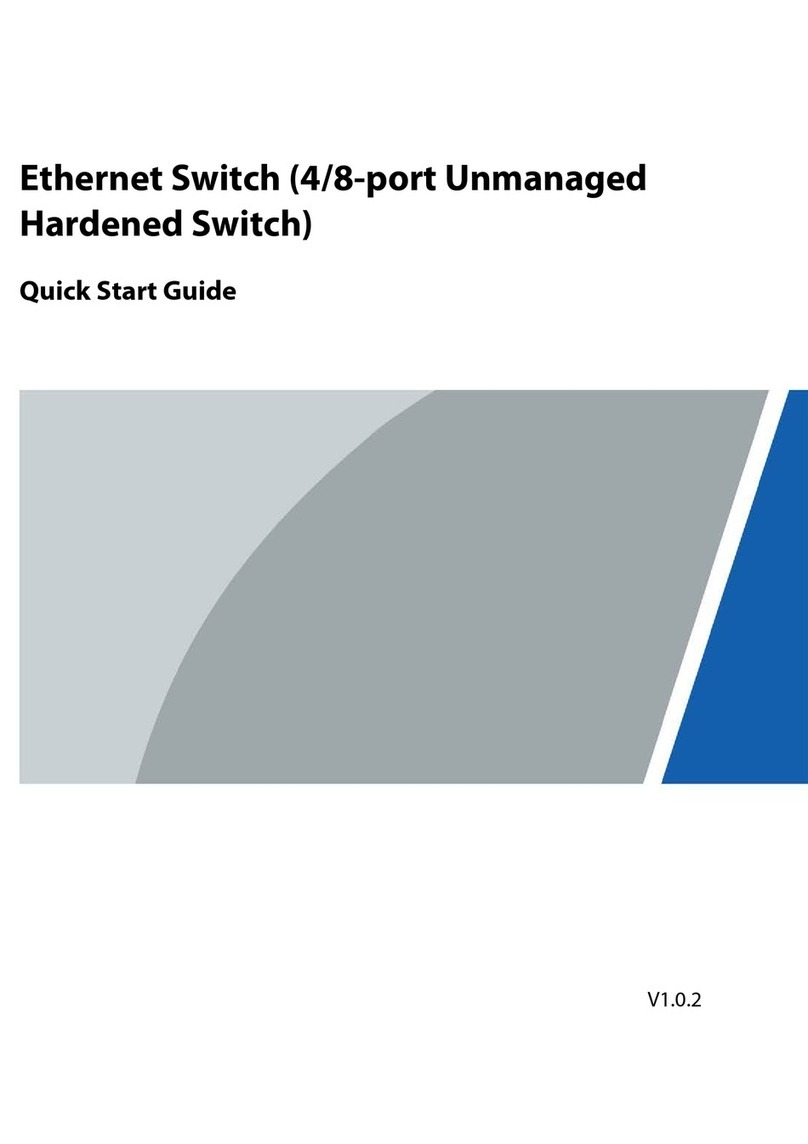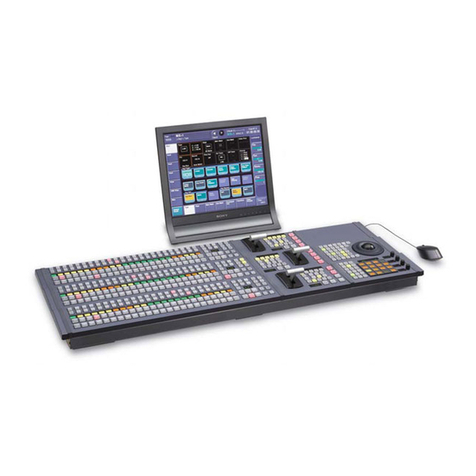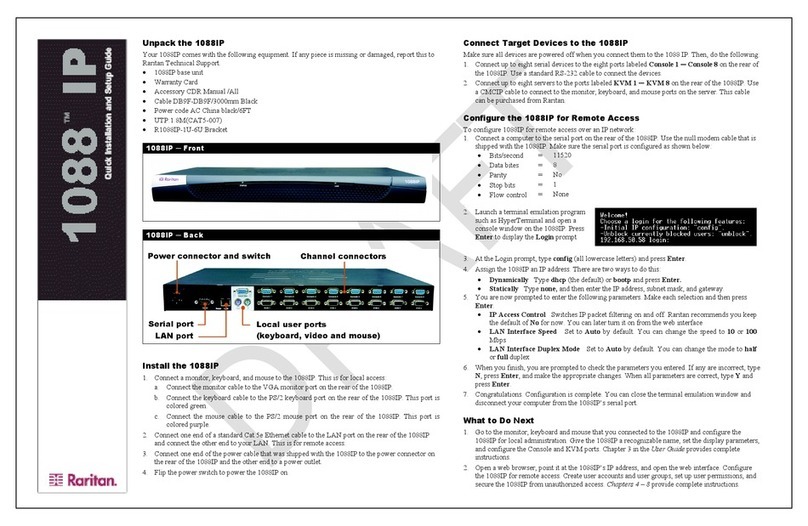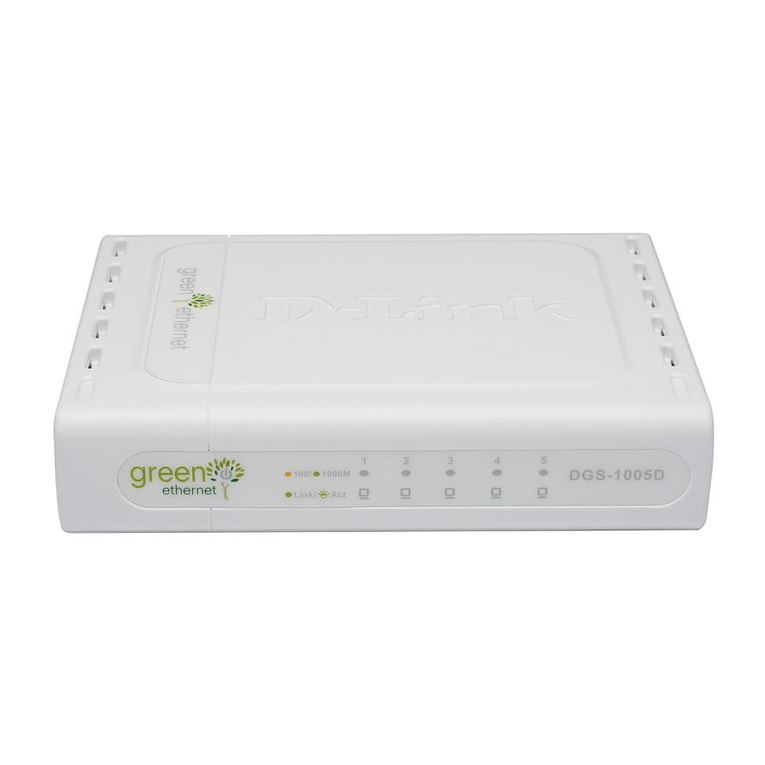Spectra Engineering RELM BK RADIO MXACU User manual

Automatic Base Station Changeover Unit
MXACU
Technical Manual


Technical Manual
MXACU
i
© SPECTRA ENGINEERING 2005 Revision 1.1.0
RELM
Wireless
C
o
r
por
a
t
ion
7100 Technology
Drive
West Melbourne, FL
32904
Front Desk: (321)
984-1414
Sales: (800)
821-2900
Service: (800)
422-6281
www.RELM.com
Manual Revision 1.1.0 September 2006
In order to continually improve our products, Spectra Engineering Pty Ltd reserves
the right to alter, without notice and at any time, the equipment and specifications
described in this document.
All performance figures quoted are typical and are subject to normal manufacturing
and service tolerances.
The purchaser is warned that statements made in this document may be inaccurate
due to typographical or other errors or subsequent modifications of the product.
While every care has been taken in the creation of this document, no warranty of
accuracy or reliability is given, in any advice or information contained in this
document. The responsibility for any loss or damage whatsoever arising in any way
or any representation, act or omission whether express or implied (including
responsibility to any person by reason of negligence) is not accepted by Spectra
Engineering Pty Ltd or any director, officer, agent or employee of Spectra
Engineering Pty Ltd.
Copyright © Spectra Engineering Pty Ltd 2005.
This work is copyright. Other than as permitted by Law, no part of it may be
reproduced, stored in a retrieval system or transmitted in any form or by any process
without prior written permission.

MXACU
Technical Manual
4
© SPECTRA ENGINEERING 2005 Revision 1.1.0
This page left blank intentionally

Technical Manual
MXACU
3
© SPECTRA ENGINEERING 2005 Revision 1.1.0
Record Of Changes
Any changes to this manual are recorded on this list. Spectra Engineering
may issue replacement pages to you from time to time. If any updates are
issued, you will also receive a replacement for this page.
Date
Version
Chapter Changes
Pages Changed
Oct 2005
1.0
All - Initial Release
All
Sept 2006
1.1
Added network ID section
22, 23

MXACU
Technical Manual
4
© SPECTRA ENGINEERING 2005 Revision 1.1.0
SAFETY SUMMARY
Although there are no dangerous mains voltages present within the equipment, the
following general safety precautions as would normally apply, should be observed
during all phases of operation, service and repair of this equipment.
AROUND THE EQUIPMENT
To minimise any possible shock hazard from an external power supply or lightning
strike, the chassis or equipment cabinet must be connected to an electrical ground.
DO NOT OPERATE IN AN EXPLOSIVE ATMOSPHERE
Do not operate the equipment in the presence of flammable gases or fumes. Operation
of any electrical equipment in such an environment constitutes a definite safety hazard.
DO NOT SUBSTITUTE PARTS OR MODIFY THE EQUIPMENT
Because of the danger of introducing additional hazards, do not install substitute or
lower voltage parts to the equipment. Return to your authorised distributor.
WARRANTY CONDITIONS & PRECAUTIONS
The following conditions are not covered by the warranty of the MXACU. Please
ensure that the MXACU is not subject to;
1. Over voltage or Reverse Power Supply Voltage.
2. Operation in locations subject to abnormal environmental conditions such as
extreme temperatures or ingress of moisture.

5
© SPECTRA ENGINEERING 2005 Revision 1.1.0
Technical Manual
Table of Contents
Table of Contents
1.
Gen
1.1
eral Description
................................................................................
8
Overview
......................................................................................
8
1.2
Front Panel
...................................................................................
8
1.2.1 Front Panel
Indicators
....................................................
9
1.2.2 Front Panel Connector
...................................................
9
1.3
Rear Panel
..................................................................................
10
2. Installation and Operation
...................................................................
13
2.1
Installation
..................................................................................
13
2.1.1
Connections...................................................................
13
2.1.2 Power Supply
................................................................
14
2.1.3 RS232 A/B
Ports............................................................
15
2.1.4 Monitor A/B
Ports
.........................................................
15
2.1.5 Line IO A/B
Ports
..........................................................
16
2.1.6 Line I/O Common
Port
..................................................
17
2.1.7 2/4 Wire Base A/B
Ports................................................
17
2.1.8 2/4 Wire Common Port
.................................................
18
2.1.9 RF Connectors
..............................................................
18
2.1.10 Digital IO
Port..............................................................
18
2.2
Operation
....................................................................................
19
2.2.1 ACU Initial power
on
....................................................
19
2.2.2 Auto
mode......................................................................
19
2.2.3 Locked
Mode.................................................................
19
2.2.4 Switching between Auto and Locked
Mode
...................
19
2.2.5 Switching Base Radios
Manually
..................................
20
2.2.6 Serial Port Routing
.......................................................
20
2.2.7 Automatic Self
Test........................................................
20
2.2.8 Resetting Alarms
...........................................................
21
3.
Rem
ote Control
.....................................................................................
22
3.1
Serial
Commands .......................................................................
22
3.2
Networked
Operation
.................................................................
22
3.2.1 Network
Commands ......................................................
22
4. Options
...................................................................................................
24
4.1 DTMF Remote control
operation
...............................................
24
4.2 PSTN
Modem.............................................................................
24
4.3 Ethernet
Port...............................................................................
24
5. Technical Description
...........................................................................
25

6
© SPECTRA ENGINEERING 2005 Revision 1.1.0
MXACU
Technical Manual
5.1 Power Supply
.............................................................................
25
5.2 Micro-controller Section
............................................................
25
5.3 RS232
Routing
...........................................................................
25
5.4 Real-time
Clock..........................................................................
26
5.5 RSSI Inputs
................................................................................
26
5.6 Relay
Drivers..............................................................................
26
5.7
DUART
......................................................................................
26
5.8 DTMF
Decoder ..........................................................................
26
5.9 Ethernet
Port...............................................................................
26
5.10 PSTN
Modem.............................................................................
26
6.
Configuration.........................................................................................
27
6.1
Requirements..............................................................................
27
6.2 Entering Set-up Mode
................................................................
27
6.3 Configuration
Menu
...................................................................
27
6.3.1 Receiver
Parameters .....................................................
27
6.3.2 Hardware Logic
Parameters.........................................
28
6.3.3 Clock
Settings
................................................................
29
6.3.4 Serial Command ID
Setting...........................................
29
6.4 Diagnostic
Menu ........................................................................
29
7. Automatic tests
......................................................................................
30
7.1
Receiver......................................................................................
30
7.2
Transmitter .................................................................................
30
7.3 DC power
...................................................................................
31
7.4 Base Radio
Alarms
.....................................................................
31
7.5 Automatic
Scheduling
................................................................
31
8.
Appendices.............................................................................................
32
8.1
Specifications .............................................................................
32
8.2 Drawings
....................................................................................
32

7
© SPECTRA ENGINEERING 2005 Revision 1.1.0
Technical Manual
Table of Contents
List of Tables
Table 1-1 LED Functions
...........................................................................................
9
Table 1-2 Rear Panel
Connections
...........................................................................
11
Table 2-1 Power Supply Connector
Pinout..............................................................
14
Table 2-2 RS232 A/B Connector
Pinout
...................................................................
15
Table 2-3 Monitor A/B Port
Pinout..........................................................................
15
Table 2-4 Line IO A/B Connector
Pinout.................................................................
16
Table 2-5 LineI/O Common Connector
Pinout.........................................................
17
Table 2-6 Base A/B Balanced Connector
Pinout.......................................................
17
Table 2-7 Common Balanced Connector
Pinout
.......................................................
18
Table 2-8 Digital I/O Connector
Pinout
...................................................................
18
Table 3-1 Serial Commands
.....................................................................................
22
Table 3-2 Network Serial
Commands
.......................................................................
23
Table 6-1 Serial Port Communication
Parameters ..................................................
27
Table 8-1 General Specifications
.............................................................................
32
Table 8-2
Drawings..................................................................................................
32
List of Figures
Figure 1-1 ACU Front
Panel......................................................................................
8
Figure 1-2 MX800 Rear Panel
.................................................................................
10

MXACU
Technical Manual
8
© SPECTRA ENGINEERING 2005 Revision 1.1.0
1. General Description
1.1 Overview
The MXACU Automatic Changeover Unit (ACU) is designed to allow
connection of two identical base radios, activating only one of the base
stations at one time in a active and standby configuration. It automatically
monitors and tests for fault conditions and switches operation to the healthiest
base station should a fault be detected.
The MXACU is a compact lightweight standard 19" rack mounting unit. It is
designed to mount horizontally in a 19" rack frame and occupies 2RU
(89mm). The depth of the unit is 330mm.
User interface is via the front and rear panels. The rear panel provides access
to all connectors and the front panel provides 8 LED indicators for the ACU
status and 4 pushbutton switches for manual operations.
1.2 Front Panel
The MXACU front panel is illustrated below.
RS232 Common
Port
Base A Select
Button
Base A Self Test
Button
Base A Active
Indicator
Base A Fault
Indicator
Base A Power
Indicator
Base A Status
Indicator
Base B Status Indicator
Base B Power Indicator
Base B Fault Indicator
Base B Active Indicator
Base B Self Test Button
Base B Select Button
Figure 1-1 ACU Front
Panel

9
© SPECTRA ENGINEERING 2005 Revision 1.1.0
Technical Manual
1.2.1 Front Panel Indicators
Table 1-1 below explains the functions of the front panel LED's. There are 4
LEDs to indicate the state for each base station and they are labelled
accordingly.
LED
FUNCTION
Active
When flashing, indicates Auto mode and that the
associated base is selected.
When solidly on, indicates Locked mode and that the
associated base is selected.
Fault
When on, indicates a fault has been detected.
When off, base has no fault detected.
Power
When on, DC supply is present on the associated
base.
When off, DC supply is not present on the associated
base.
Status
When on, external serial communication is directed
to the associated base.
When off, external serial communication is disabled
to the associated base.
Table 1-1 LED Functions
1.2.2 Front Panel Connector
The DB9 male connector located on the front panel is wired directly in
parallel with the DB9 male connector marked “RS232 COMMON” on the
rear of the ACU. Please refer to Table 1-2 for the function of this connector.
Note You must not have any equipment plugged into the rear serial
connector if you want to use this connector for serial communication
with the ACU.

10
© SPECTRA ENGINEERING 2005 Revision 1.1.0
MXACU
Technical Manual
1.3 Rear Panel
The MXACU front panel is illustrated in Figure 1-2 below.
RS232 A Port
Monitor A Port
RS232 B Port
Monitor B Port
Balanced Line Common
Relay, TRM & Aux Terminals
Power Input Terminals
Optional Ethernet Port
Line IO Base A Port
Line IO Base B Port
2/4Wire Base A Port
2/4Wire Base B Port
Optional PSTN Modem Port
Digital IO Port
RS232 Common Port
Line IO Common Port
Base B TX RF Port
Common TX RF Port
Base A TX RF Port
Figure 1-2 MX800 Rear
Panel
Both screw terminal connectors can be unplugged if required. This is
achieved by unscrewing the retaining screws on either side of the plug and
then pulling the plug outwards.
Table 1-2 on the following page explains each connector on the rear of the
ACU’s function.

11
© SPECTRA ENGINEERING 2005 Revision 1.1.0
Technical Manual
Type
Label
Function
DB15
FEMALE
LINE I/O
COMMON
Provides the necessary analogue receiver and
transmitter interface for system interfacing.
DB9
MALE
RS232
COMMON
Serial port to connect to a PC running MXTools
programming software.
RJ45
2/4 WIRE
COMMON
If a balanced line connection is used for base station
operation, the connection is made to this connector.
RJ45
2/4 WIRE
BASE A/B
These are connected to each base station’s balanced
line connector if a balanced line option is fitted.
DB15
MALE
LINE I/O
A/B
These are connected to the A and B base station’s
Line IO connector and are required for ACU
operation.
DB9
FEMALE
RS232 A/B
These are connected to the A and B base station’s
serial ports and are required for ACU operation.
DB9 MALE
MONITOR
A/B
These are connected to the A and B base station’s
monitor ports and are required for ACU operation.
N TYPE
BASE A TX
Connect the transmitter output of base station A to
this connector.
N TYPE
BASE B TX
Connect the transmitter output of base station B to
this connector.
N TYPE
COMMON
TX
RF output of the selected base station that is to be
connected to the antenna system.
SCREW
TERMINALS
12V
IN / GND
12Volt (13.8 Volt nominal) DC power inputs. On
this connector is 3 individual inputs that are diode
ORed together allowing the ACU to be connected to
multiple power supplies simultaneously. The
negative connection (GND) of the 3 inputs is
common.
SCREW
TERMINALS
AUX/GND
Reserved for future expansion.
SCREW
TERMINALS
RELAY/
GND
This output is switched to +12volts when the B side
base station is selected.
SCREW
TERMINALS
TRM/
GND
This output is reserved for the optional turn around
mixer.
DB9
FEMALE
ACU
DIGITAL
I/O
This connector allows interfacing to external
supervisory equipment. At has signals present for
monitoring base station faults and ACU status.
RJ12
PSTN
When the optional modem is fitted, this connects to a
standard telephone line using this port.
RJ45
ETHERNET
When the Ethernet option is fitted, this connector
provides a standard 10 Base-T/100 Base-Tx network
port.
Table 1-2 Rear Panel Connections

12
© SPECTRA ENGINEERING 2005 Revision 1.1.0
MXACU
Technical Manual
This page left blank intentionally

13
© SPECTRA ENGINEERING 2005 Revision 1.1.0
Technical Manual
2. Installation and Operation
2.1 Installation
The MXACU is securely packed for transport with special end packers within
a pasteboard container. Before unpacking the MXACU, please inspect the
packaging for signs of damage and report any damage to your distributor.
Upon unpacking the MXACU, please ensure that all items shipped were
received, report any missing items to your distributor.
All ports on the rear of the ACU should be carefully examined to ensure that
packaging has not become wedged inside them.
If you intend to install the radio in an equipment rack consult the suppliers
instructions for your system. Spectra Engineering strongly recommends that
the ACU be secured into the rack system using four screws through the
mounting holes in the front panel near the handles. It is recommended that the
chassis is earthed to the equipment rack.
Equipment connection details are located in Section 2.1.1. The MXACU will
require approximately 80mA (At 13.8V) when base station A is selected or
350mA when base station B is selected.
2.1.1 Connections
2.1.1.1 Rear Panel Connections
Connections to the Automatic Changeover Unit are made at the rear and
allow connections to the two MX800 transceivers, a common 2/4 wire E&M
line port, a common RS232 port and a common line IO interface port.
The changeover unit switches these three common ports either to the ‘A’
MX800 when it is selected or the ‘B’MX800 transceiver when it has been
selected.
Connector configuration and orientation is such that the MXACU can be
installed in a rack with the ‘A’ side MX800 above and the ‘B’ side MX800
below the ACU. The RJ45 line connection, the D15 line IO, the D9 monitor
and D9 serial connections are directly above/below the corresponding
MX800 ports.
The ACU requires connections to each of the following connectors on
MX800 base radios:
CN1 –Line I/O
CN2 –DB9 Monitor port
CN4 –DB9 RS232 serial port
CN8 –N Type transmitter RF output
Also when T04/T05/T19 or similar balanced line options are fitted to the base
radios, connections to CN9 –RJ45 line are required.

14
© SPECTRA ENGINEERING 2005 Revision 1.1.0
MXACU
Technical Manual
The ACU switches CN1, CN4, CN8 and CN9 from the selected base radio to
additional ports on the rear of the ACU for interfacing to external equipment.
An internal coaxial changeover relay is connected to both MX800 RF
transmitter outputs and this switches transmitter output to a common antenna
port. Only one MX800 transmitter is enabled at any time, with both
transmitters completely disabled during the switch over sequence.
The ACU has a D9 (CN2) digital logic IO port that can be interfaced to a
supervisory system to provide an operating status of the ACU and the current
fault status of the connected MX800s.
Please refer to drawing number CS407 in Section 8.2 for a view of ACU and
MX800 inter-connections.
2.1.2 Power Supply
Power for the ACU is connected to the 6 way pluggable screw terminal block
on the rear. Connections are clearly marked on the rear panel. There are
three DC inputs on this connector allowing connections to be made to three
separate DC supplies with these inputs diode OR-ed before regulation within
the ACU. In most installations, it is envisaged that if each base radio had it’s
own DC supply, these both could also supply the ACU with provision for a
third input if another supply is available.
Maximum operating current needed to supply the ACU is around 350mA @
13.8V.
ACU DC input terminal block connections:
Pin
TB1 Function
Note
1
+12V DC Power Input A
(+13.8V) DC supply input diode OR-ed
3
+12V DC Power Input B
(+13.8V) DC supply input diode OR-ed
5
+12V DC Power Input C
(+13.8V) DC supply input diode OR-ed
2,4,6
GND
Power negative - Chassis GND
Table 2-1 Power Supply Connector Pinout

15
© SPECTRA ENGINEERING 2005 Revision 1.1.0
Technical Manual
2.1.3 RS232 A/B Ports
The RS232 A and B male DB9 connectors are configured so that they can be
connected directly to the A and B side base stations. Only 3 pins are needed
however, all 9 pins maybe connected without any ill affects.
Pin
Function
Note
2
TX Data
Data to MX800
3
RX Data
Data from MX800
5
GND
GND
Table 2-2 RS232 A/B Connector Pinout
2.1.4 Monitor A/B Ports
The Monitor A and B female DB9 connectors are configured so that they can
be connected directly to the A and B side base stations. Only 7 pins are
needed for ACU interfacing however, all 9 pins maybe connected without
any ill affects.
Pin
Function
Note
1
RSSI GND reference
This pin is not connected to GND in the ACU
2
RSSI Value
Raw RSSI voltage input
3
PTT Control
This is an output from the ACU
4
Forward TX Power
Raw Fwd voltage input
5
DC Supply Voltage
Raw DC supply input
6
Reverse TX Power
Raw Rev voltage input
9
TX Tone
This is an AF output from the ACU
Table 2-3 Monitor A/B Port Pinout

16
© SPECTRA ENGINEERING 2005 Revision 1.1.0
MXACU
Technical Manual
2.1.5 Line IO A/B Ports
These DB15 male ports connect each MX800’s Line IO connector (CN1) to
the ACU. All 15 pins need to be connected in a 1 to 1 configuration.
It is recommended that the cable used between the ACU and the base stations
be shielded.
Pin
Function
Note
1
ALM2
Connect to Pin 1 of appropriate MX800 CN1
2
TX VF Loop back
Connect to Pin 2 of appropriate MX800 CN1
3
RX VF Audio 5ohm
Connect to Pin 3 of appropriate MX800 CN1
4
RX Discriminator
Connect to Pin 4 of appropriate MX800 CN1
5
ALM3
Connect to Pin 5 of appropriate MX800 CN1
6
ALM1 or M Lead
Connect to Pin 6 of appropriate MX800 CN1
7
RX Talk
Connect to Pin 7 of appropriate MX800 CN1
8
TTR enable
Connect to Pin 8 of appropriate MX800 CN1
9
TX VF Audio 600ohm
Connect to Pin 9 of appropriate MX800 CN1
10
GND
Connect to Pin 10 of appropriate MX800 CN1
11
TX Talk
Connect to Pin 11 of appropriate MX800 CN1
12
PTT
Connect to Pin 12 of appropriate MX800 CN1
13
TX DC FM audio
Connect to Pin 13 of appropriate MX800 CN1
14
Mute
Connect to Pin 14 of appropriate MX800 CN1
15
RX VF Audio 600ohm
Connect to Pin 15 of appropriate MX800 CN1
Table 2-4 Line IO A/B Connector Pinout

17
© SPECTRA ENGINEERING 2005 Revision 1.1.0
Technical Manual
2.1.6 Line I/O Common Port
Pin
Function
Note
1
ALM2
Signal routed from selected MX800
2
TX VF Loop back
Signal routed to selected MX800
3
RX VF Audio 5ohm
Signal routed from selected MX800
4
RX Discriminator
Signal routed from selected MX800
5
ALM3
Signal routed from selected MX800
6
ALM1 or M Lead
Signal routed from selected MX800
7
RX Talk
Signal routed to selected MX800
8
TTR enable
Signal routed to selected MX800
9
TX VF Audio 600ohm
Signal routed to selected MX800
10
GND
Signal Ground
11
TX Talk
Signal routed to selected MX800
12
PTT
Signal routed to selected MX800
13
TX DC FM audio
Signal routed to selected MX800
14
Mute
Signal routed from selected MX800
15
RX VF Audio 600ohm
Signal routed from selected MX800
Table 2-5 LineI/O Common Connector Pinout
2.1.7 2/4 Wire Base A/B
Ports
The functions of the 2/4/wire balanced ports are dependent on the MX800
options fitted. The individual signals from these pins are switched via relay
contacts to the same pins on the 2/4 wire common port.
Connector: RJ45 Socket (8P8C)
Pins
Function
Note
1 to 8
Various
Dependent on MX800 option board if fitted.
Table 2-6 Base A/B Balanced Connector Pinout

18
© SPECTRA ENGINEERING 2005 Revision 1.1.0
MXACU
Technical Manual
2.1.8 2/4 Wire Common Port
See the explanation above for the pin assignment of this port.
Connector: RJ45 Socket (8P8C)
Pins
Function
Note
1 to 8
Various
Dependent on MX800 option board if fitted.
Table 2-7 Common Balanced Connector Pinout
2.1.9 RF Connectors
These connectors are for switching the selected base station transmitter
output through to the antenna system (or RF combiner network). They are
internally connected to a SPDT coaxial relay.
Connectors: ‘N’ Type Female
Pin
Function
Note
Top
Base A TX RF input
Switched to the antenna output when Base
A is selected.
Centre
Antenna output
Bottom
Base B TX RF input
Switched to the antenna output when Base
B is selected.
2.1.10 Digital IO Port
This port can be connected to external supervisory circuits such as a
telemetry system to monitor system status and performance.
Connector: DB9 Female
Outputs: NPN open collector (Active low)
Pin
Function
Note
1
Reserved
Future use
2
Reserved
Future use
3
Reserved
Future use
4
Reserved
Future use
5
GND
GND
6
Base ‘A’ fault output
Active = fault detected
7
Base ‘B’ fault output
Active = fault detected
8
Current selected output
Inactive = ‘A’, Active = ‘B’
9
ACU health output
Toggles @ 1Hz while healthy
Table 2-8 Digital I/O Connector Pinout
Table of contents
Popular Switch manuals by other brands
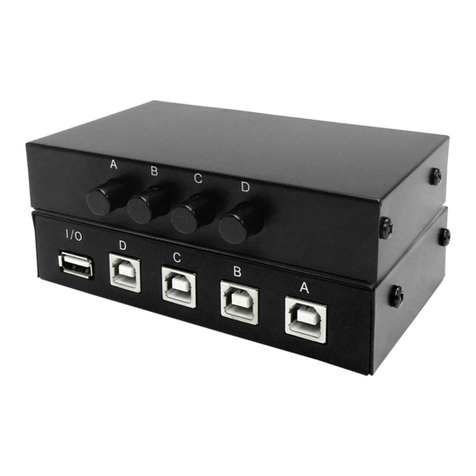
Renkforce
Renkforce RF-4106952 operating instructions
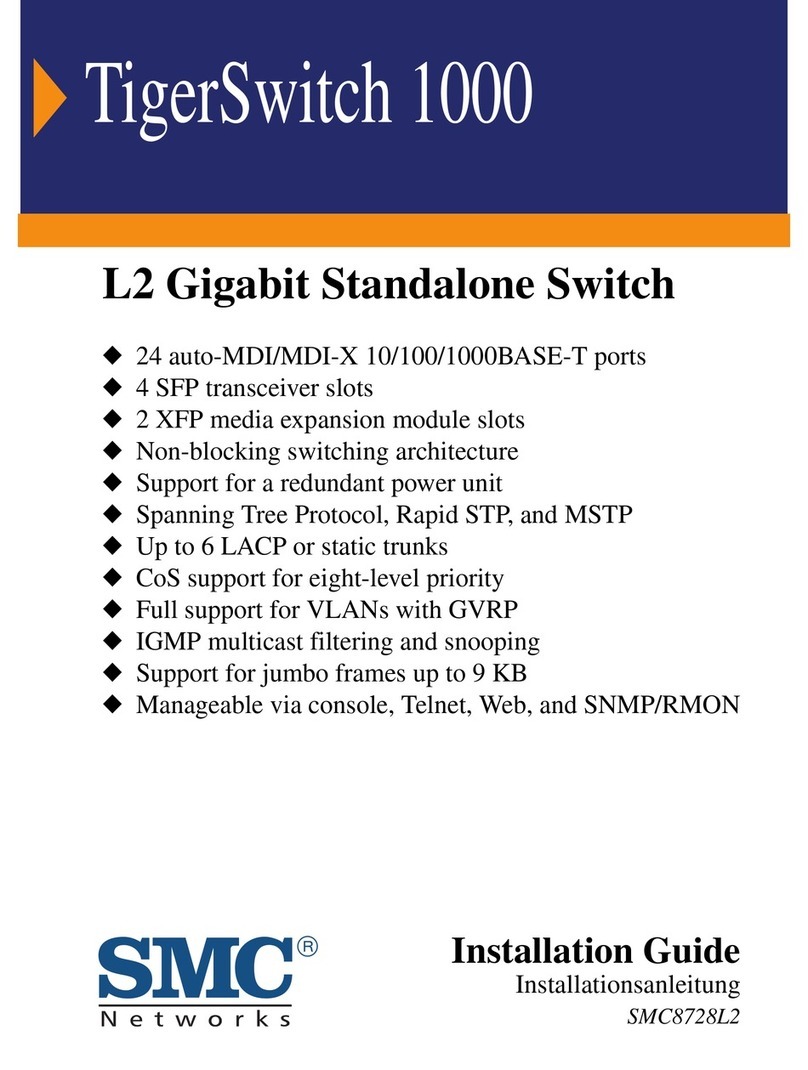
SMC Networks
SMC Networks TigerSwitch SMC8728L2 installation guide

TESmart
TESmart HKS0802A1U user manual
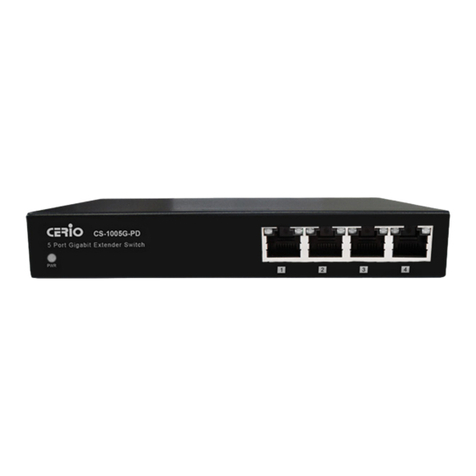
Cerio
Cerio CS-1005G-PD user guide
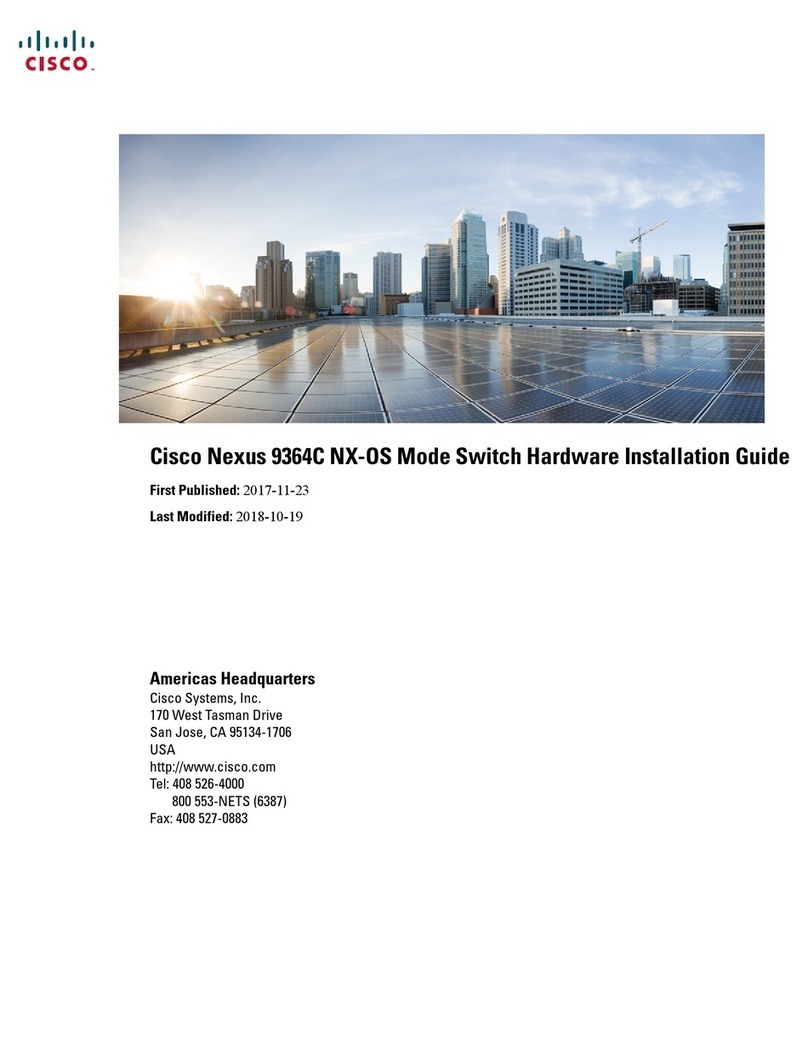
Cisco
Cisco Nexus 9364C Hardware installation guide
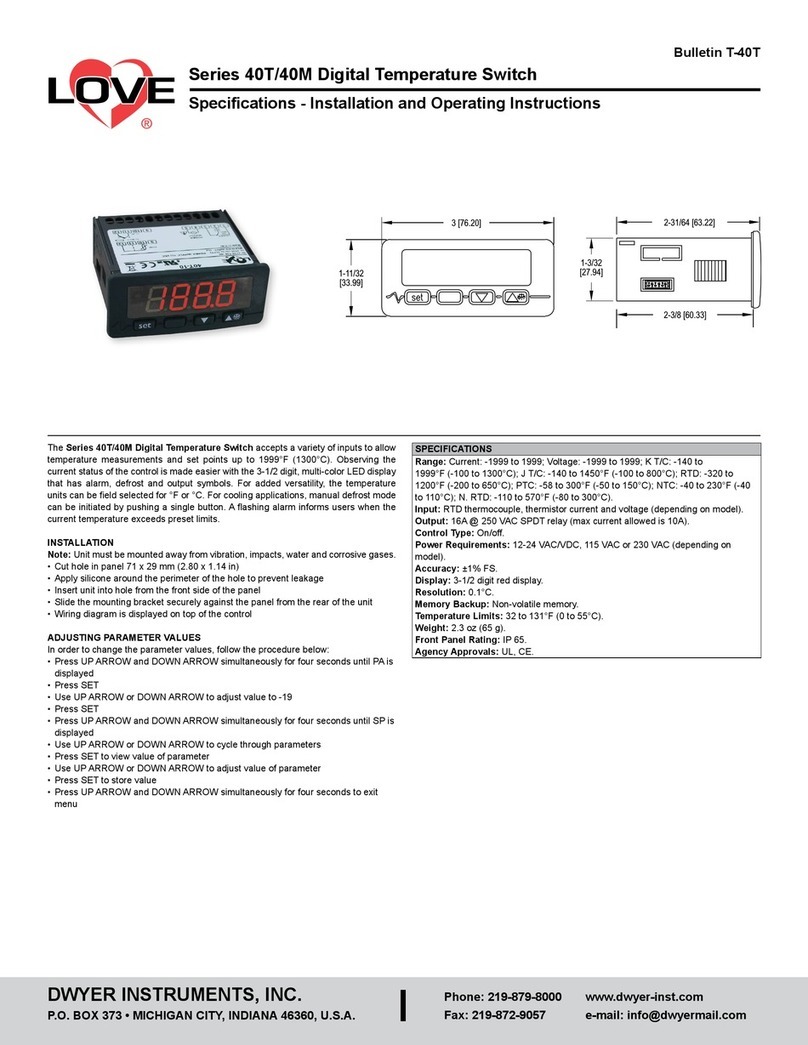
Dwyer Instruments
Dwyer Instruments Love 40T Series Specifications-installation and operating instructions

Weidmüller
Weidmüller IE-SW-EL08-8PoE Hardware installation guide
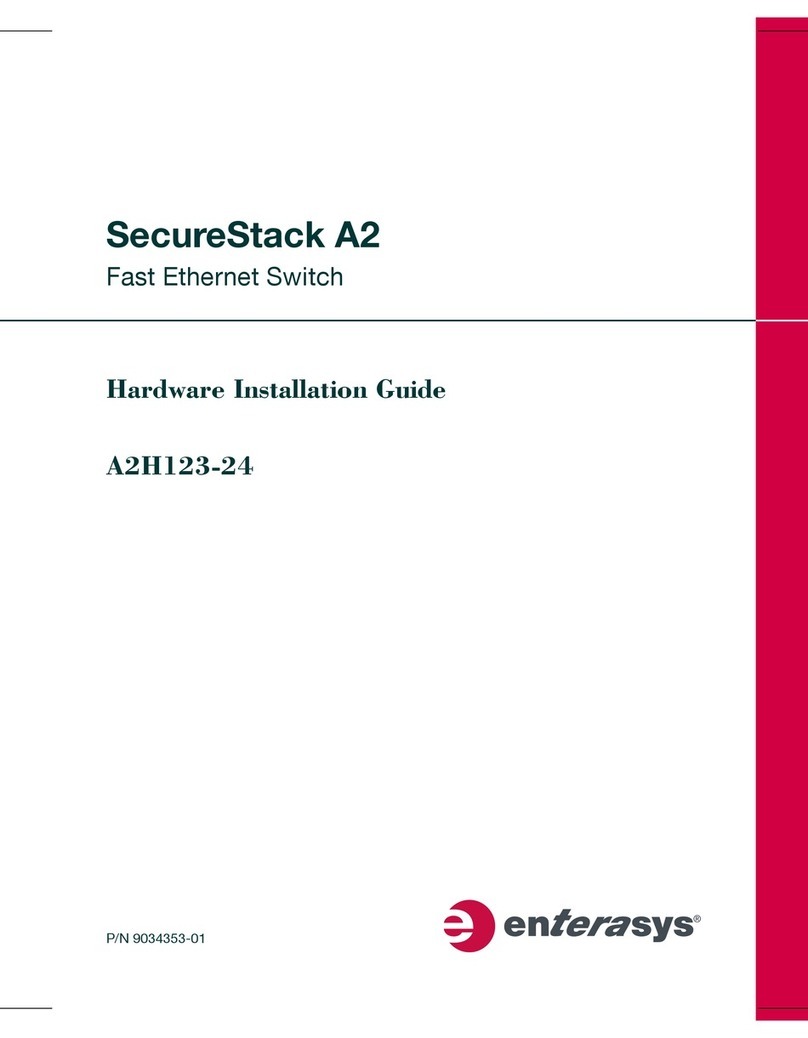
Enterasys
Enterasys SecureStack A2 A2H123-24 Hardware installation guide

Allied Telesis
Allied Telesis AT-9800 Series Quick install guide
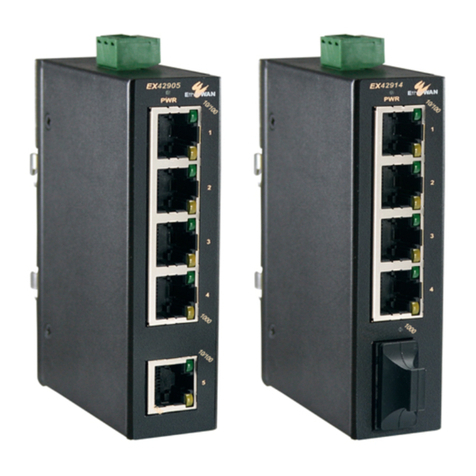
EtherWAN
EtherWAN EX42914 Series quick start guide
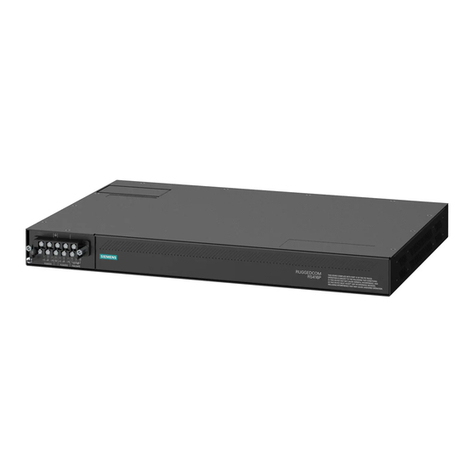
Siemens
Siemens SIMATIC NET RUGGEDCOM RS416P installation manual

Belden
Belden Hirschmann SPIDER-SL-20-01T1S29999SZ9HHHH user manual
